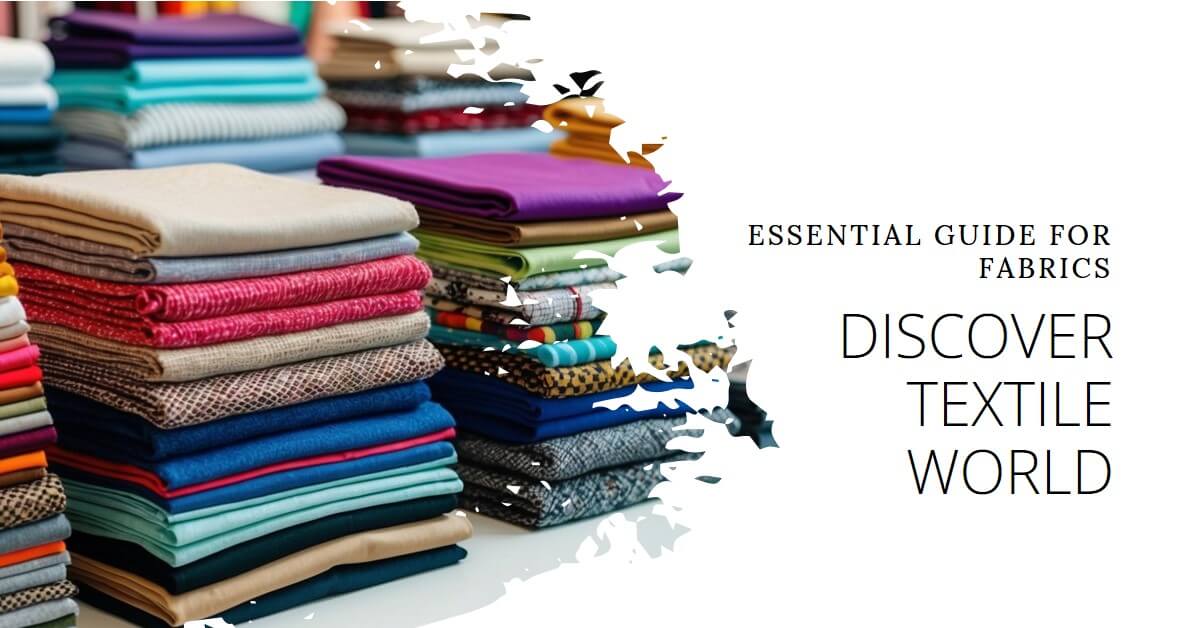Fabric is a remarkable material that surrounds us every day. I’ve always been fascinated by how different fabrics can change the look and feel of clothing, home decor, and more. Fabric is made from fibres that are woven, knitted, or bonded together to create a wide range of textures and properties.
When I choose fabrics for my projects, I consider factors like comfort, durability, and care requirements. Cotton is soft and breathable, making it great for everyday wear. Polyester is tough and wrinkle-resistant, perfect for travel clothes. Silk feels luxurious against the skin, while wool keeps you warm in cold weather.
Learning about different fabric types can help you make better choices for your sewing and crafting projects. It’s amazing how the right fabric can elevate a simple garment or give new life to an old piece of furniture. With so many options available, there’s always something new to discover in the world of textiles.
On This Page
Key Takeaways
- Fabrics are made from various fibres with unique properties
- Choosing the right fabric impacts comfort and durability of garments
- Understanding fabric types helps in selecting the best material for projects
Understanding Fibres and Their Properties
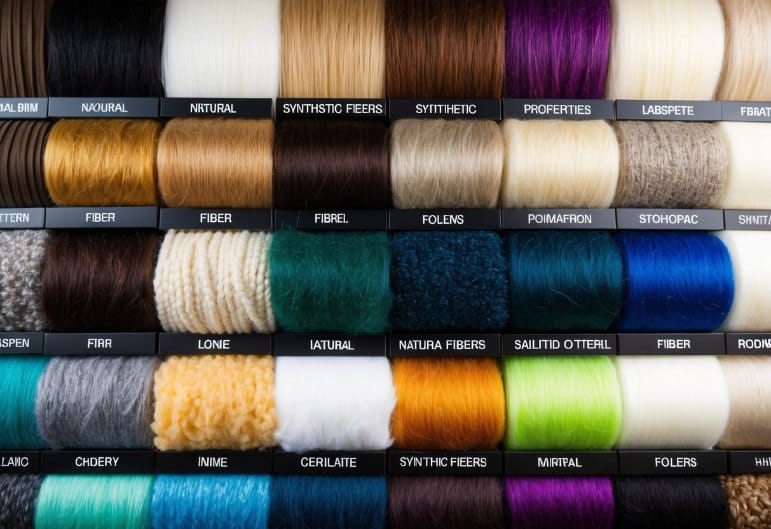
Fibres are the building blocks of fabrics. They come in many types, each with unique traits that affect how a fabric looks, feels, and performs. Let’s explore the world of fibres and how they become the clothes we wear.
Natural vs Synthetic Fibres
Natural fibres come from plants and animals. Cotton, silk, wool, and linen are common examples. These fibres are often soft, breathable, and eco-friendly.
Synthetic fibres are man-made. Nylon, polyester, and acrylic fall into this group. They’re often stronger and more durable than natural fibres. Many can resist wrinkles and dry quickly.
Some fibres, like rayon, blur the line. They’re made from natural materials but go through chemical processing. This makes them ‘semi-synthetic’.
Key Fibre Types
Cotton: Soft, breathable, and easy to care for. It’s great for everyday clothes.
Silk: Smooth and lustrous. It’s perfect for luxury items.
Wool: Warm and naturally water-resistant. Ideal for cold-weather gear.
Polyester: Strong, wrinkle-resistant, and quick-drying. It’s used in many sportswear items.
Nylon: Tough and elastic. It’s often used in stockings and outdoor gear.
Spandex: Super stretchy. It’s added to other fabrics to make them more flexible.
Hemp: Strong and durable. It’s becoming more popular in eco-friendly fashion.
Fibre to Fabric Process
The journey from fibre to fabric starts with harvesting or creating raw fibres. For cotton, this means picking the fluffy bolls from plants. For synthetics, it involves extruding liquid polymers through tiny holes.
Next, fibres are cleaned and aligned. They’re then spun into yarn. This yarn can be thick or thin, depending on the desired fabric.
The yarn is then woven or knitted into fabric. Weaving creates a crisscross pattern, while knitting forms interlocking loops.
Finally, the fabric is finished. This might include dyeing, printing, or treating it to add special properties like water resistance.
Fabric Constructions
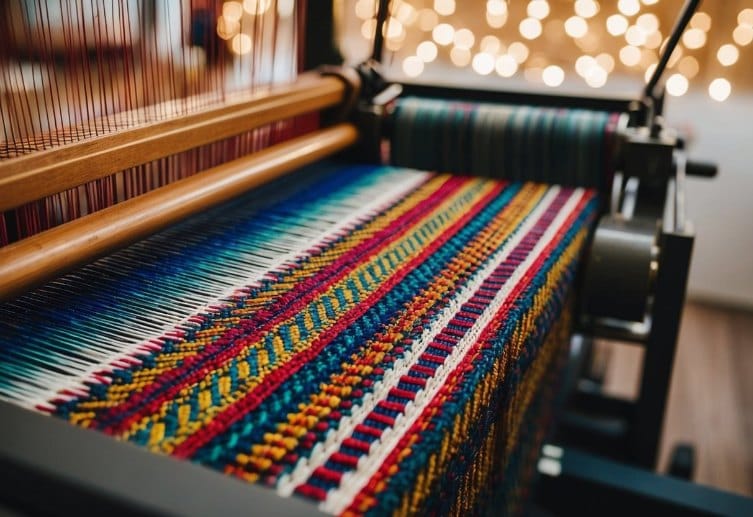
Fabric construction methods shape how textiles look, feel, and function. These techniques create unique properties that suit different uses.
Woven Fabrics
I find woven fabrics fascinating. They’re made by interlacing two sets of yarns at right angles. The lengthwise yarns are called the warp, while the crosswise ones are the weft. Looms are used to weave these yarns together.
Woven fabrics come in many patterns. Plain weave is the simplest, with yarns going over and under each other evenly. Twill weave creates diagonal lines, like in denim. Satin weave has a smooth, shiny surface.
These fabrics are usually sturdy and don’t stretch much. They’re great for shirts, trousers, and bedding. Woven fabrics tend to fray at the edges when cut.
Knit Fabrics
Knit fabrics are quite different. They’re made with a single yarn that forms interlocking loops. This structure gives knits their stretch and flexibility.
There are two main types of knits: weft knits and warp knits. Weft knits, like T-shirt fabric, are stretchier. Warp knits, such as tricot, are more stable.
Knit fabrics are comfy and move well with the body. They’re perfect for jumpers, leggings, and underwear. Unlike wovens, knits don’t fray easily when cut.
Non-Woven Fabrics
Non-woven fabrics are unique. They’re not made by weaving or knitting. Instead, fibres are bonded together using heat, chemicals, or pressure.
Felt is a classic non-woven fabric. It’s made by matting wool fibres together. Other non-wovens include interfacing used in sewing and some types of medical masks.
These fabrics can be very thin or thick. They often don’t fray or unravel. Non-wovens are used in disposable items, craft projects, and industrial applications.
Popular Fabric Types and Their Uses
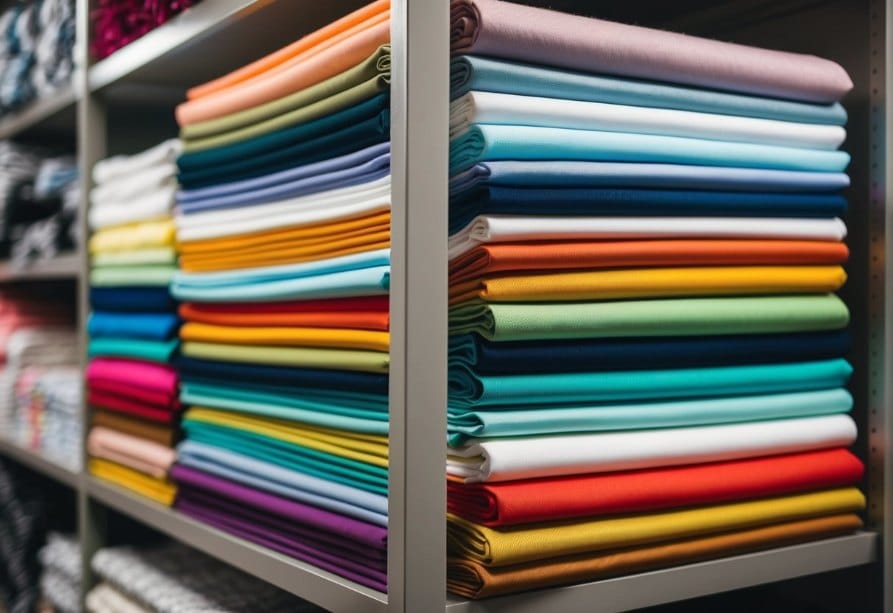
Fabrics come in many varieties, each suited for different purposes. I’ll explore some common fabrics used in clothing, speciality applications, and home furnishings. These materials have unique properties that make them ideal for specific uses.
Everyday Wear
Denim is a sturdy cotton twill fabric I love for jeans and jackets. It’s durable and gets softer with wear. Cotton is breathable and comfortable for t-shirts and casual clothes. I find polyester great for easy-care garments that resist wrinkles.
For dressier items, I often choose satin. Its smooth, shiny surface looks elegant. Tencel is another favourite of mine. It’s soft like silk but more eco-friendly.
I sometimes pick acetate for linings. It’s lightweight and drapes well. For cooler weather, I go for wool. It’s warm and naturally water-resistant.
Speciality and Performance Fabrics
When I need tough outdoor gear, I look for canvas. It stands up to heavy use. Waterproof fabrics like Gore-Tex keep me dry in rain.
For sports, I choose moisture-wicking activewear fabrics. They help keep me cool and dry during exercise.
Velvet is my go-to for luxurious evening wear. Its soft pile feels amazing. Jacquard fabrics with woven patterns add visual interest to special occasion clothes.
For travel clothes, I prefer wrinkle-resistant fabrics. They look fresh even after being packed in a suitcase.
Home and Upholstery
For home decor, I love the versatility of cotton and linen. They work well for curtains, tablecloths, and bedding. Upholstery fabrics need to be durable. I choose tough materials like leather or microfibre for sofas.
Twill weaves are great for furniture. They’re strong and hide stains well. For a fancy look, I might pick brocade or damask. These richly patterned fabrics dress up a room.
In the kitchen, I use cotton terry cloth for tea towels. It’s absorbent and dries quickly. For outdoor cushions, I select fabrics treated to resist fading and mildew.
Fabric Properties and Selection
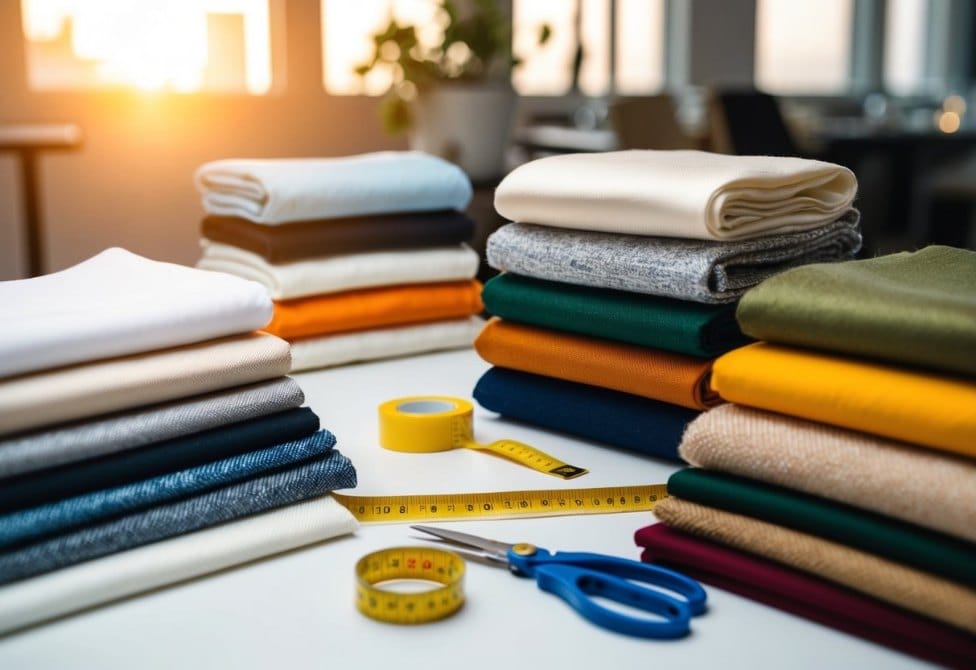
Selecting the right fabric involves considering key properties that affect how it performs and feels. I’ll explore the main factors to keep in mind when choosing fabrics for different uses.
Strength and Durability
Fabric strength is crucial for long-lasting garments and home textiles. I look at the fibre type and weave structure to assess durability.
Natural fibres like cotton and linen are quite strong, but can wrinkle easily. Synthetic fibres like polyester and nylon tend to be very durable and resist wear.
Tightly woven fabrics are typically stronger than loose weaves. Twill and satin weaves offer good durability for everyday wear.
For high-stress areas like seams and pockets, I choose reinforced or heavier weight fabrics. Denim and canvas are top choices for rugged use.
Comfort and Breathability
The feel of a fabric against skin greatly impacts comfort. I always consider texture, weight and moisture management.
Soft, lightweight fabrics like cotton jersey and silk feel lovely for casual wear. Wool and fleece provide warmth without bulk for cooler weather.
Breathable fabrics allow air flow and moisture evaporation. Natural fibres like cotton, linen and wool excel here.
Moisture-wicking fabrics pull sweat away from skin. This is ideal for activewear – look for special polyester blends.
Stretch fabrics with elastane offer freedom of movement. They’re perfect for fitted styles and athletic gear.
Care and Maintenance
Proper care keeps fabrics looking their best. I always check care labels before buying or cleaning fabrics.
Machine-washable fabrics like cotton and polyester are low-maintenance choices. Delicate fabrics such as silk often need hand washing or dry cleaning.
Some fabrics shrink or fade easily. I pre-wash cotton to prevent later shrinkage. Dark colours may need special detergents to prevent fading.
Wrinkle-resistant fabrics save ironing time. Synthetic blends and treated cottons are good options here.
Stain-resistant finishes help fabrics stay clean longer. This is useful for upholstery and kids’ clothing.
Creative Applications and Sewing Tips
Fabric opens up endless possibilities for creative expression and DIY projects. I’ll share some exciting ways to use fabric in fashion design and crafts.
Fabric in Fashion Design
Fashion designers love playing with different fabrics to bring their ideas to life. I’ve seen how printed fabrics can add flair to a simple dress or jacket. Knit fabrics work great for comfy tops and dresses that move with you.
Some fabrics need special care. I always check the label – if it says “dry clean only”, I take it to the cleaners. It’s worth the extra effort to keep special pieces looking their best.
I enjoy mixing textures too. A silky blouse paired with a rough tweed skirt creates an interesting contrast. The key is to experiment and find what looks and feels good to you.
DIY Projects and Crafts
Sewing projects are a fun way to use up fabric scraps. I’ve made everything from quilted blankets to decorative pillows. Even small bits of fabric can become cute accessories like hair bows or phone cases.
For beginners, I suggest starting with simple projects like tote bags or placemats. These let you practise basic skills without getting too complex.
Don’t be afraid to get creative! I once turned an old pair of jeans into a funky purse. The options are endless when you start thinking outside the box.
Remember, not all crafts need sewing. You can use fabric glue for no-sew projects like bunting or fabric-covered notebooks. It’s a great way to add a personal touch to your home or gifts.
Frequently Asked Questions
What are the basics of fabric?
The basics of fabric involve understanding its composition, texture, and structure. Fabrics are made from fibres that are either natural (like cotton or wool) or synthetic (such as polyester or nylon).
These fibres are spun into threads and then woven or knitted together to form fabric. Fabrics also vary in weight, stretch, and durability, which influence their best uses.
Which fabric is best for beginners?
For beginners, cotton is an excellent choice. It is easy to work with, affordable, widely available, and comes in a variety of patterns and colours.
Cotton fabric doesn’t slip or stretch too much, making it ideal for those new to sewing or fabric crafts.
What are fabric fundamentals?
Fabric fundamentals involve understanding the fibres used to create fabric (natural, synthetic, or blends), the construction methods (woven, knitted, or non-woven), and the fabric’s properties such as durability, breathability, and stretch.
These basics guide the choice of fabric for different uses, from clothing to home décor.
What are the 4 things to consider when choosing fabric?
When choosing fabric, consider:
1. Purpose: What will the fabric be used for? Clothing, upholstery, or crafts?
2. Durability: How well does the fabric hold up to wear and washing?
3. Comfort: Is the fabric soft, breathable, and appropriate for the season?
4. Ease of Care: Can it be easily washed and maintained, or does it require special care?
What are the three main types of fabric?
The three main types of fabric are:
1. Woven fabrics: Created by interlacing two sets of yarns at right angles, such as cotton and denim.
2. Knitted fabrics: Made by looping yarns together, offering stretch and flexibility, like jersey and fleece.
3. Non-woven fabrics: Produced by bonding fibres together, such as felt.
What is fabric with holes in it called?
Fabric with holes is often referred to as lace or mesh, depending on the style and use. Eyelet fabric also has deliberate, decorative holes, often reinforced with stitching around the openings.
What are textile basics?
Textile basics refer to the fundamental concepts of fabrics, including the types of fibres (natural, synthetic), the construction of textiles (woven, knitted), and the properties of different materials.
Understanding these basics helps in selecting the right textile for specific purposes, like durability or softness.
What is that fuzzy fabric called?
The fuzzy fabric you might be thinking of is fleece or velvet. Fleece is known for its soft, warm texture, while velvet has a rich, luxurious feel with a plush surface.
How can I tell what kind of fabric something is?
To identify a fabric, you can:
• Feel it: Natural fabrics like cotton or wool feel softer, while synthetics like polyester are smoother.
• Look at the weave: Woven fabrics have a criss-cross pattern, while knits have loops.
• Burn test: Carefully burn a small fabric swatch. Natural fibres tend to burn quickly and leave ash, while synthetics melt and form a plastic bead.
What is the first method of fabric?
The first method of fabric creation was weaving, dating back to ancient times. It involves interlacing yarns at right angles to create a sturdy textile.
What is a bumpy fabric called?
A bumpy fabric is often called bouclé. It has a looped or knotted texture, giving it a distinctive bumpy or curly surface.
What is the difference between a textile and a fabric?
Textile refers to any material made from fibres, yarn, or fabric, while fabric specifically refers to the material that is woven or knitted together.
In simple terms, all fabrics are textiles, but not all textiles are fabrics.
Which fabric is best for daily use?
For daily use, cotton is the best choice due to its breathability, softness, and durability. Cotton is comfortable for everyday wear and holds up well to frequent washing.
What is wrinkled fabric called?
Wrinkled fabric is often called crinkled or seersucker. These fabrics are intentionally wrinkled or puckered, giving them a distinctive textured look that doesn’t require ironing.

